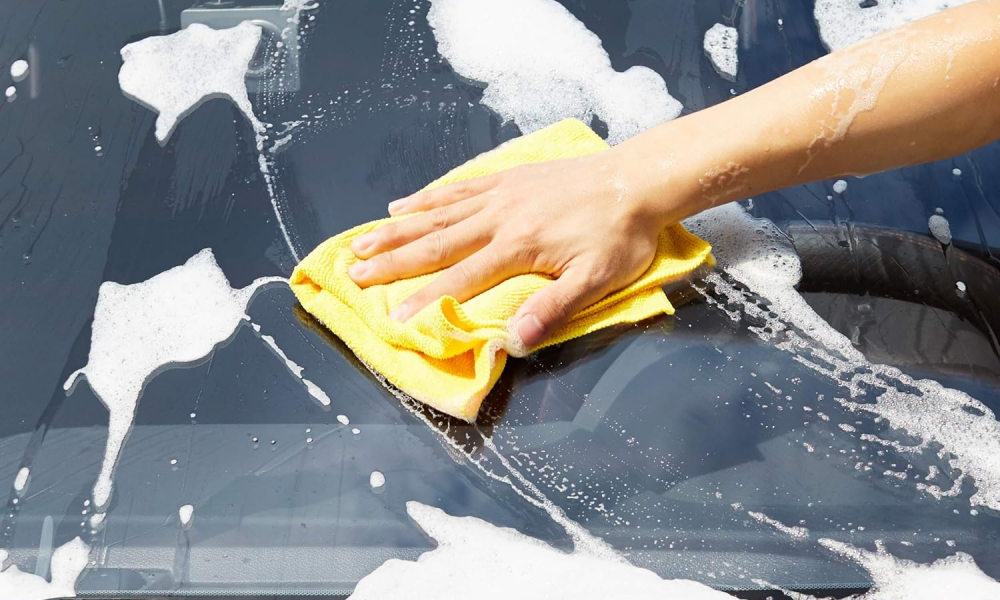
7 Interior Car Cleaning Products You Need in 2024

Maintaining a clean interior not only enhances the driving experience but also preserves the value of your vehicle. Investing in quality interior car cleaning products can save you a significant amount of money on professional cleaning services over time. Here’s a guide to essential products that will help you keep your car’s interior in top condition.
Microfiber Cloth
Microfiber cloths are an indispensable tool in the arsenal of car cleaning products, especially when it comes to maintaining the interior of your vehicle. These cloths are made from a blend of polyester and polyamide, which gives them their unique ability to attract and trap dust, dirt, and grime without the need for chemical cleaners. Their soft, non-abrasive texture ensures that they can be used on all types of surfaces without the risk of scratching or damaging them. Here’s a deeper dive into why microfiber cloth is so beneficial and how to use it effectively.
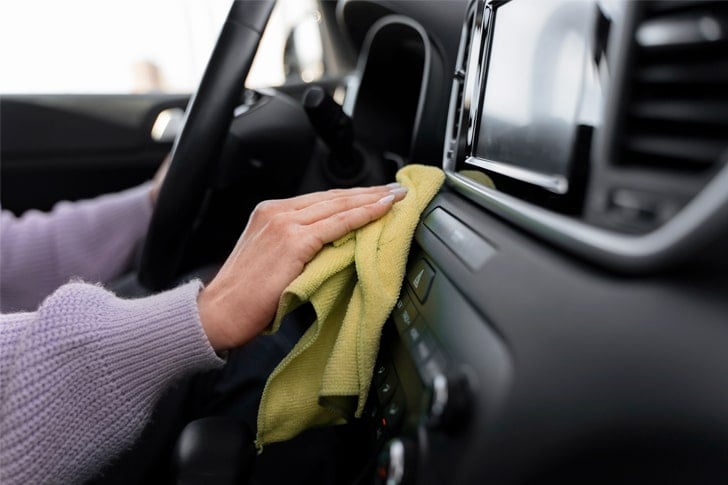
freepik / freepik
Advantages of Microfiber Cloth
High Absorbency
Microfiber cloth can absorb up to seven times its weight in water, making it perfect for wiping down surfaces that have been cleaned with liquid products or for drying interior components that have come into contact with water.
Electrostatic Properties
The fibers in these cloths are positively charged, attracting dust and other negatively charged particles. This makes them exceptionally effective at picking up dust from dashboard surfaces, vents, and electronic screens without spreading it around.
Reusable and Eco-Friendly
Unlike paper towels, microfiber cloths can be washed and reused numerous times, reducing waste and making them an eco-friendly option for car care.
Versatility
These cloths are suitable for a variety of tasks, including dusting, polishing, and cleaning glass surfaces. They can be used dry for dusting and lightly dampened for more intensive cleaning.
Using Microfiber Cloth Effectively
Dry Dusting
For light dusting, use a dry microfiber cloth in a circular motion to pick up dust. This is particularly effective on the dashboard, steering wheel, and other hard surfaces.
Wet Cleaning
When dealing with more stubborn dirt or stains, lightly dampen the microfiber cloth with water or an appropriate cleaning solution. The dampened cloth will help lift and remove grime from surfaces.
Polishing
After cleaning surfaces with a damp microfiber cloth, use a dry one to buff and polish the area. This is especially useful for creating a streak-free finish on glass and shiny surfaces.
Care and Maintenance
To ensure your microfiber cloth remains effective, wash it separately from other laundry to avoid lint transfer. Use mild detergent and avoid fabric softeners, as they can clog the fibers and reduce their effectiveness. Air drying is preferred, but if you use a dryer, choose a low-heat setting.
Car Vacuum Cleaner
A car vacuum cleaner is a crucial component for maintaining the cleanliness and hygiene of your vehicle’s interior. Unlike standard household vacuum cleaners, car vacuums are specifically designed to be compact, portable, and powerful enough to reach the nooks and crannies of a vehicle. They come in various forms, including corded models that plug into the vehicle’s 12V outlet and cordless models that offer greater mobility without the hassle of a cord. Understanding the features and proper use of a car vacuum cleaner can significantly enhance your vehicle’s interior maintenance routine.
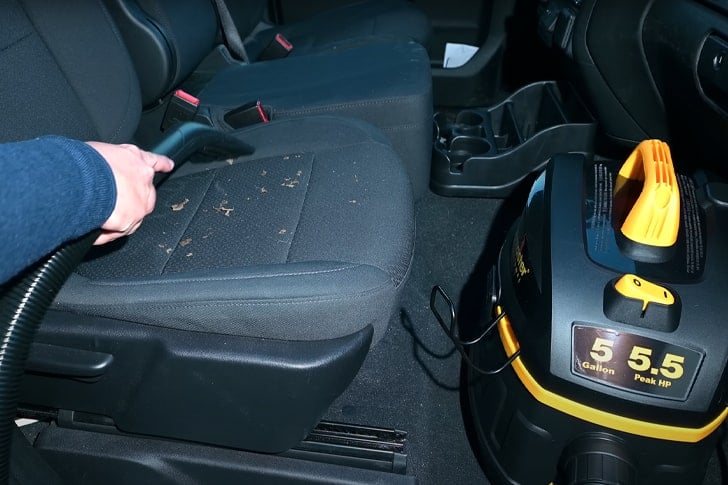
Vacuum Wars / Youtube
Key Features of a Car Vacuum Cleaner
Power Source
A vacuum cleaner for car may be powered through the car’s 12V socket or be battery-operated. Corded models usually offer sustained suction power for longer cleaning sessions, whereas cordless vacuums provide the convenience of portability and ease of use.
Attachments and Accessories
They often come with a variety of attachments tailored for vehicle cleaning. These can include crevice tools for tight spaces, brush attachments for upholstery, and flexible hoses to reach under seats and deep into footwells.
Suction Power
The effectiveness of a car vacuum cleaner is largely determined by its suction power. Higher suction power is better for removing embedded dirt, pet hair, and other stubborn debris from car mats, seats, and trunk areas.
Size and Portability
Compact and lightweight designs are preferred for ease of maneuverability inside the car. Portable models can be easily stored in the trunk or under a seat for quick access.
Using Vacuum Cleaner for Car Effectively
Regular Maintenance
To prevent buildup that can impair suction performance, it’s important to regularly empty the dust container or replace the bag in your car vacuum cleaner. Filters should also be cleaned or replaced according to the manufacturer’s instructions.
Strategic Cleaning
Start by removing larger pieces of debris and mats from the car to make vacuuming more efficient. Use the attachments of the vacuum cleaner for car strategically; for example, use the crevice tool to clean between seats and the brush attachment for the dashboard and door panels.
Systematic Approach
Begin cleaning from the top down, starting with the dashboard, console, and then moving to the seats, and finally the floors. This ensures that any dislodged dirt falls to the floor, which is vacuumed last.
Deep Cleaning
For a thorough clean, move the seats forward and backward to reach areas underneath. Pay special attention to the footwells, under the pedals, and the area under the seats, as these are places where dirt and debris tend to accumulate.
Tips for Optimal Use
Pre-Cleaning
Before using a vacuum cleaner for car, shake out floor mats and seat cushions outside the car to dislodge as much dirt as possible. This makes the vacuuming process quicker and more effective.
Battery Care for Cordless Models
To ensure your wireless handheld car vacuum cleaner is always ready for use, keep its battery charged according to the manufacturer’s guidelines. Avoid leaving it discharged for long periods to preserve battery life.
Noise Level
Consider the noise level of the car vacuum cleaner, especially if you will be cleaning in residential areas where high noise could be disruptive. Some models are designed to operate more quietly while still providing strong suction.
Car Interior Cleaner
Car interior cleaners are an essential product designed to tackle the unique cleaning challenges presented by the diverse materials found within a vehicle’s cabin. These cleaners are formulated to safely and effectively clean surfaces such as leather, vinyl, plastic, upholstery, and carpets without causing damage. A good car interior cleaner removes dust, dirt, grime, and stains, while also sometimes offering conditioning properties to protect surfaces and keep them looking new. Understanding the types of car interior cleaners and their proper use is key to maintaining a pristine car interior.
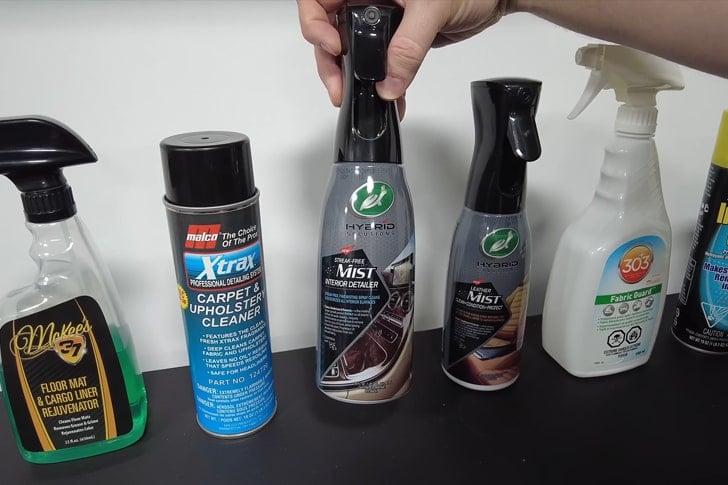
Pan The Organizer / Youtube
Types of Car Interior Cleaners
Multi-Purpose Cleaner
These are versatile and can be used on a variety of surfaces. They are ideal for everyday cleaning tasks and are effective at removing surface dirt and grime.
Upholstery and Carpet Cleaner
Specially formulated to tackle stains and dirt on fabric surfaces. These car interior cleaners often come with attachments or brushes designed to work the product into the fibers for a deep clean.
Car Leather Cleaner
Designed for cleaning and conditioning leather surfaces. They gently remove dirt and oils while moisturizing the leather, preventing it from drying out and cracking.
Plastic and Vinyl Cleaners
These car interior cleaners remove fingerprints, dust, and stains from hard surfaces, such as the dashboard, door panels, and center console, without leaving a greasy residue.
Using a Car Interior Cleaner Effectively
Test First
Always test the car interior cleaner on a small, inconspicuous area to ensure it does not damage or discolor the surface.
Follow Directions
Use the car interior cleaner according to the manufacturer’s instructions. Some cleaners may require dilution, while others are ready to use.
Use Appropriate Tools
Apply the car interior cleaner with a microfiber cloth, sponge, or specific brush as recommended for the surface. This helps to avoid scratching or damaging delicate materials.
Work in Sections
Clean the interior in sections, focusing on one area at a time. This allows you to thoroughly clean and dry each area before moving on to the next, preventing the car interior cleaner from sitting too long and potentially damaging the surfaces.
Avoid Over-Saturation
Especially on upholstery and carpets, avoid using too much product, as excessive moisture can lead to mold and mildew growth. Instead, spray lightly and work the car interior cleaner into the fabric with a brush before wiping away or vacuuming.
Condition After Cleaning
For leather surfaces, follow up with a car leather conditioner after cleaning to replenish essential oils and protect the leather from future wear and tear.
Tips for Maintaining a Car Interior Cleaner
Routine Cleaning
Regularly wipe down surfaces with a microfiber cloth and car interior cleaner to prevent the buildup of dirt and grime.
Stain Management
Address spills and stains immediately to prevent them from setting and becoming more difficult to remove.
Avoid Direct Sunlight
When cleaning the interior, try to do so in the shade or on a cloudy day. Direct sunlight can cause some car interior cleaners to evaporate too quickly, potentially leaving residue or streaks.
Car Leather Conditioner
Car leather conditioner is a crucial product for maintaining the health, appearance, and longevity of leather car interiors. Leather, being a natural material, requires regular care to prevent it from drying out, cracking, or fading. Car leather conditioner is designed to penetrate the leather’s surface, providing moisture, restoring suppleness, and protecting it from wear and tear. Understanding how to choose and use a leather conditioner effectively is key to keeping your car’s leather seats and surfaces in top condition.
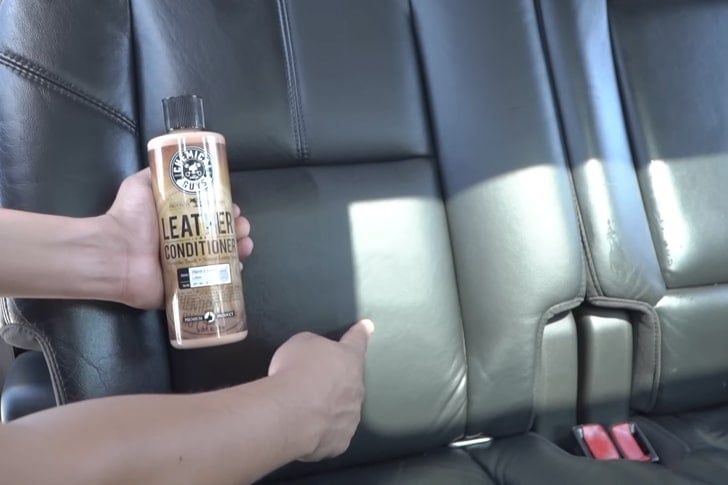
Chemical Guys / Youtube
Choosing a Car Leather Conditioner
Compatibility
Ensure the car leather conditioner is suitable for the type of leather in your car. Automotive leather can vary in its treatment and finish, and some conditioners are formulated specifically for certain types of leather.
Ingredients
Look for a car leather conditioner that contains natural oils and waxes as these ingredients are effective at moisturizing leather without damaging it. Avoid products with harsh chemicals or solvents that can strip the leather of its natural oils.
Finish
Consider whether you want a glossy or matte finish. Some car leather conditioners can leave behind a shine, while others are designed to maintain the leather’s natural matte look.
Applying Car Leather Conditioner
Clean First
Before applying a car leather conditioner, ensure the leather is clean and free of dust, dirt, and grime. Use a gentle leather cleaner and allow the surface to dry completely.
Test
As with any care product, test the car leather conditioner on a small, inconspicuous area to check for any adverse reaction or discoloration.
Apply Sparingly
Car leather conditioner should be applied sparingly to avoid over-saturation, which can make the leather feel greasy or slippery. Use a soft cloth or sponge to apply the conditioner in a thin, even layer.
Massage Into Leather
Gently massage the car leather conditioner into the leather in circular motions, allowing it to penetrate the surface. This helps to ensure even coverage and maximizes absorption.
Let It Absorb
Allow the car leather conditioner to absorb into the leather for the time recommended by the product instructions, typically a few hours. Avoid using or placing anything on the leather during this time.
Buff Off Excess
After the car leather conditioner has been absorbed, buff the leather with a clean, dry microfiber cloth to remove any excess product and bring out a natural shine.
Maintenance and Care Tips
Regular Conditioning
Depending on the climate and how often the vehicle is used, condition the leather every three to six months to keep it soft and protected.
Avoid Direct Sunlight
Prolonged exposure to sunlight can fade and damage leather. Park in the shade or use sunshades to protect the interior when parked.
Protect From Stains
Clean spills immediately and consider using a leather protector to help repel stains and water, making future cleaning easier.
Car Upholstery Cleaner
Car upholstery cleaner is an essential product for maintaining the interior of a vehicle, especially for seats and surfaces not covered in leather. Car upholstery can be made from a variety of materials, including fabric, vinyl, and synthetic blends, each with its unique cleaning requirements. A good car upholstery cleaner will not only remove dirt and stains but also help to preserve the material’s integrity and appearance over time.
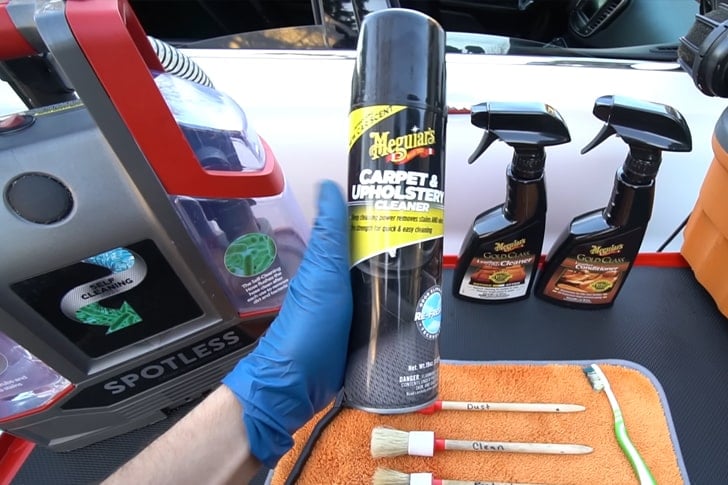
ChrisFix / Youtube
Understanding Car Upholstery Cleaners
Types of Cleaners
There are different formulations of car upholstery cleaners available, including sprays, foams, and liquids. Each type has its advantages depending on the nature of the cleaning task and the type of upholstery material.
Ingredients
Quality car upholstery cleaners are designed to effectively break down and lift away stains and dirt without damaging the fabric. Look for cleaners that specify their suitability for automotive use, as these will be formulated to tackle the kinds of stains and wear commonly found in vehicles.
Safety
It’s important to choose a car upholstery cleaner that is safe for use on your specific type of upholstery. Some cleaners may contain harsh chemicals that could fade or weaken certain fabrics. Always check the label for any warnings or recommended usage guidelines.
Using Car Upholstery Cleaner Effectively
Vacuum First
Before applying a car upholstery cleaner, thoroughly vacuum the upholstery to remove loose dirt, dust, and debris. This prevents dirt from being worked deeper into the fabric during the cleaning process.
Spot Testing
Always perform a spot test in an inconspicuous area before applying the car upholstery cleaner to larger sections. This ensures that the car upholstery cleaner does not adversely affect the color or texture of the upholstery.
Application
Follow the instructions on the car upholstery cleaner for the best application method. Some products may need to be diluted, while others can be used directly from the bottle. Apply the car upholstery cleaner evenly across the surface, using a brush or cloth as directed.
Agitation
For tough stains, gently agitate the car upholstery cleaner into the fabric with a soft brush or microfiber cloth. This helps to loosen the dirt and lift it from the fibers.
Rinsing (If Required)
Depending on the car upholstery cleaner, you may need to rinse the area with clean water to remove any residue. This is more common with certain liquid cleaners or if the product instructions specify rinsing.
Drying
Allow the upholstery to dry completely before using the vehicle. This may take several hours or overnight, depending on the material and weather conditions. Adequate drying is crucial to prevent mold or mildew growth.
Maintenance Tips
Regular Cleaning
Regular maintenance can prevent the buildup of dirt and stains, making it easier to keep your car’s interior looking its best.
Stain Removal
Address spills and stains as soon as possible to prevent them from setting. The longer a stain remains, the harder it may be to remove.
Protective Measures
Consider using car seat covers or protective sprays designed for automotive upholstery to help shield the fabric from wear and stains.
Glass Cleaner for Cars
Auto glass cleaner is a specialized product designed to maintain the clarity and cleanliness of automotive glass, including windows, mirrors, and sometimes even the windshield. The importance of keeping these areas clean cannot be overstated, as it directly impacts driving visibility and safety. A good glass cleaner for cars removes dirt, grime, fingerprints, and other marks without leaving streaks or residue behind.
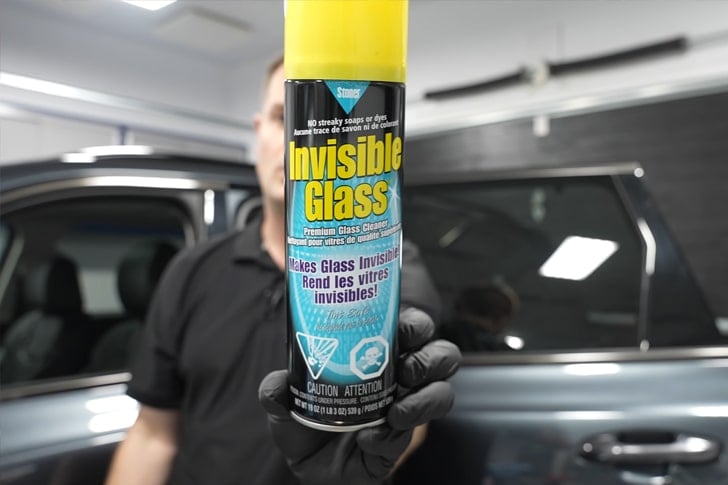
Pan The Organizer / Youtube
Understanding Auto Glass Cleaners
Formulations
Auto glass cleaners are formulated to be strong enough to cut through tough grime, such as road spray and oily fingerprints, yet gentle enough not to damage tinted windows or other surfaces. They typically come in spray bottles for easy application but can also be found in concentrated forms or wipes.
Ingredients
Look for an auto glass cleaner that does not contain ammonia, as ammonia can damage window tints and other vehicle surfaces. Alcohol or vinegar-based cleaners are popular for their effectiveness in leaving a streak-free finish.
Compatibility
Ensure the glass cleaner for cars is safe for all types of automotive glass and window tints. Some auto glass cleaners are specifically designed to be safe for tinted windows, which is crucial if your vehicle has them.
Using Glass Cleaner Effectively
Preparation
Begin by ensuring the glass is cool to the touch and the vehicle is out of direct sunlight. This reduces the chances of the cleaner evaporating too quickly and leaving residues.
Application
Spray the auto glass cleaner onto the glass surface or onto a microfiber cloth. This can help prevent overspray onto non-glass surfaces and control the amount of product used.
Wiping
Use a clean, lint-free microfiber cloth to wipe the auto glass cleaner across the surface in a circular or back-and-forth motion. This helps to lift and remove dirt and ensures an even application without streaks.
Buffing
After cleaning, use a dry side of the cloth or a second clean cloth to buff the glass. This helps to achieve a crystal-clear finish by removing any lingering product or streaks.
Detailing
For best results, pay special attention to the edges and corners of the glass, where grime and streaks are most likely to accumulate. A separate microfiber cloth or a soft-bristled brush can help in these tighter areas.
Maintenance Tips
Regular Cleaning
Incorporating glass cleaning into your regular car maintenance routine ensures optimal visibility and maintains the aesthetic appeal of your vehicle.
Inside and Out
Remember to clean both the interior and exterior surfaces of the glass. Interior glass can accumulate films from the off-gassing of interior materials and should not be overlooked.
Avoid Contaminants
To prevent scratching or damage, ensure your cleaning cloths are free of debris and dirt before use. Washing microfiber cloths separately from other laundry can help maintain their effectiveness.
Car Air Fresheners
Car air fresheners for cars are designed to maintain a pleasant and inviting aroma inside the vehicle, combating odors from food, pets, smoke, and everyday use. They come in various forms and fragrances, allowing drivers to personalize the scent of their vehicle’s interior. Understanding the different types of car air fresheners and their application will help you choose the right one for your needs and preferences.
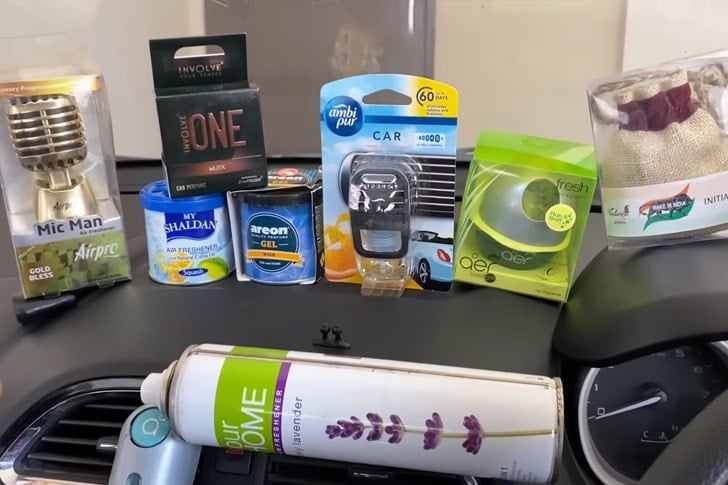
Info n Tech / Youtube
Types of Car Air Fresheners
Hanging Cardboard
These are perhaps the most familiar type of car air fresheners. They are inexpensive, come in various scents, and are typically hung from the rearview mirror. While effective for temporary odor masking, their scent can fade relatively quickly.
Vent Clips
Vent clip air fresheners attach directly to the vehicle’s air vents. As air flows through the vents, it disperses the fragrance throughout the car. This type provides a more consistent scent distribution and is less intrusive than hanging air fresheners.
Canister and Gel
These car air fresheners come in small containers that can be placed under seats or in cup holders. They slowly release fragrance over time and often allow for adjustable scent intensity. Gel air fresheners are particularly versatile in terms of placement and typically last longer than cardboard types.
Sprays
Car air freshener sprays offer the advantage of immediate relief from odors. They can be applied as needed and are effective for targeting specific areas within the vehicle. However, their effect is usually short-lived and may require frequent application.
Plug-ins
Similar to home plug-in air fresheners, these car air fresheners plug into the vehicle’s 12V socket, releasing a fragrance as they heat up. They are effective for consistent scent dispersion and often feature adjustable settings to control the fragrance level.
Oil Wicks
These car air fresheners use a wick that absorbs fragrance oil from a container, releasing the scent into the air. They are compact and can be placed discreetly within the car. The intensity of the fragrance can often be adjusted by exposing more or less of the wick.
Choosing the Right Car Air Fresheners
Scent Preference
With a wide range of available fragrances, from fresh and airy to sweet and spicy, choose a scent that you enjoy and find relaxing for driving.
Duration and Intensity
Consider how long you want the air freshener to last and the intensity of the fragrance. Some prefer a subtle scent that lasts longer, while others might favor a stronger aroma that can be adjusted or replaced more frequently.
Sensitivity to Scents
For those sensitive to strong fragrances, opt for car air fresheners that offer adjustable intensity levels or choose a more naturally scented or unscented option to avoid discomfort.
Application and Maintenance
Decide how much effort you are willing to put into maintaining the scent in your car. Some car air fresheners require more frequent replacement or adjustment than others.
Maintenance Tips
Regular Cleaning
The most effective way to maintain a fresh-smelling car is to keep the interior clean. Regularly remove trash, vacuum the seats and floors, and wipe down surfaces with a microfiber cloth.
Odor Elimination
Before introducing a new air freshener, try to eliminate any existing bad odors. This might involve deep cleaning fabric surfaces or using a dedicated odor-eliminator product.
More inDriving
-
`
U.S. Reduces Tariffs on Japanese Cars to 15% Under Trump’s Deal
In a move reshaping U.S.-Japan trade relations, former President Donald Trump confirmed a new agreement that slashes tariffs on Japanese car...
August 9, 2025 -
`
Adults in Ohio Face Stricter Rules to Obtain Driver’s License
Ohio has passed a new law that will change the way adults under 21 get their driver’s licenses. Signed into law...
July 31, 2025 -
`
Gen Z Craves Career Guidance, But Their Parents Are Struggling Too
Gen Z is stepping into the future with curiosity and ambition—but they’re not doing it alone. A growing number of teens...
July 25, 2025 -
`
Do Car Insurance Companies Offer Pay-As-You-Go Plans?
Car insurance premiums often feel unfair to people who rarely drive. Yet, most traditional auto policies still charge a fixed monthly...
July 17, 2025 -
`
Why the Koenigsegg Sadair Spear Is the Ultimate Hypercar Beast
Koenigsegg has revealed a new beast—the Sadair’s Spear. Tuning its focus on raw performance and brutal speed, this hypercar marks the...
July 11, 2025 -
`
Which States Have the Safest—and Riskiest—Drivers in America?
Driving safety isn’t just about skill. It’s also about location. A recent nationwide report shines a spotlight on where drivers are...
July 4, 2025 -
`
How to Save on Tesla Car Insurance Without Compromising Coverage
Owning a Tesla often brings savings on fuel and a futuristic driving experience, but the conversation changes quickly when it comes...
June 26, 2025 -
`
10 Weird Cars That Turned Heads and Won Hearts
Some cars turn heads with speed, others with luxury—but a rare few grab your attention simply by being delightfully strange. From...
June 20, 2025 -
`
Next-Gen Jeep Cherokee Expected to Arrive by Late 2025
After a break of two years, Jeep is prepared to relaunch the Cherokee brand. The automaker confirmed the return with fresh...
June 12, 2025















You must be logged in to post a comment Login